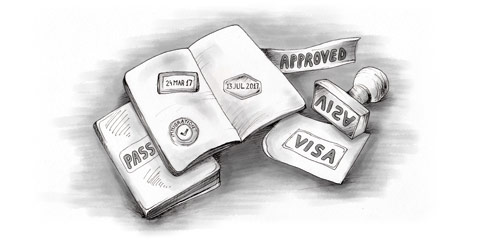Many non-immigrant visas are of the multiple-entry type, allowing you to enter and leave the US as often as you wish while the visa is valid. Keep in mind that your visa expiration date determines only when you can enter the US, not how long you can stay there. Your length of stay is determined by the date stamped in your passport at the port of entry.
If you have a valid non-immigrant visa but your passport expires, your visa will remain valid as long as you bring your old passport with you when traveling to the US. The Border Protection Immigration Officer will issue a new stamp in your current passport, this is known as VIOPP (visa in other passport).
Documentation and fees
All applicants filing for a non-immigrant visa must first submit a Non-immigrant Visa Application (form DS-160) to the Department of State electronically. There may also be supplemental forms for certain students, exchange program participants and potential investors.
Each applicant must also pay a non-refundable application fee, which is currently $160 for most visa types. Depending on your visa category and country of citizenship, you may also have to pay an issuance fee when your application is approved.
Interview
Nearly all visa applicants are required to have an interview with a consular visa official, though this interview may last only a few minutes.
Depending on the category of visa you’ve applied for, the interviewer may ask questions about your employment or occupation, education and qualifications, finances, living circumstances, and personal background.
If you’re unemployed or have recently left school or university, your application may be reviewed more meticulously, as the consular official may suspect that you’re planning to look for work in the US. If you’re going to the US as a visitor, you should have a return ticket, firm plans regarding your travels and what you intend to do after your visit, in addition to sufficient funds to cover your expenses for the period of your stay.
It is advisable to bring any supporting documentation that may help you answer interview questions. For example, someone interviewing for a visitor visa may bring an employment contract from their home country to confirm their obligation to return from the US.
Categories of non-immigrant visas
There are over 35 categories of non-immigrant visas, each of which is designated by a letter.
The two most common types are for business and tourism visitors:
- B-1 visas are for business travelers to consult with business associates, attend a conference, settle an estate, or negotiate a contract in the US
- B-2 visas are for tourists on vacation and people coming for medical treatment, a social event, or participation in unpaid amateur contests
For a full list of non-immigrant visa classifications, visit the Department of State website .
Change of status
Many non-immigrant visas can be extended, provided your status remains unchanged and the period of admission you were granted hasn’t expired. It is also possible to switch from one non-immigrant visa to another after arrival in the US.
Foreigners already in the US applying for an extension of stay or a change of non-immigrant status must submit an Application to Extend/Change Nonimmigrant Status (form I-539) to the USCIS. Applicants must also pay a filing fee of $370 as well as any other applicable biometric services fees.
This article has been adapted from Living and Working in America.

